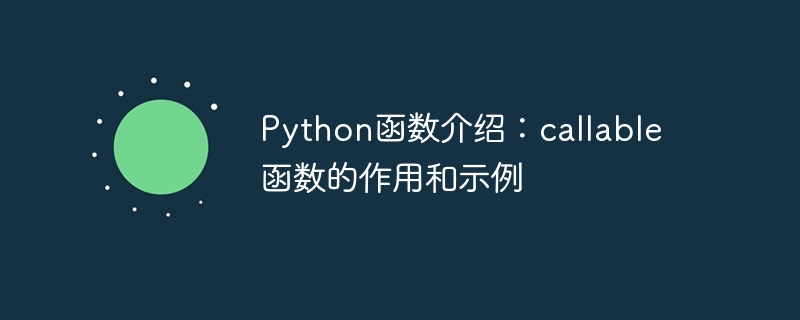Home >Backend Development >Python Tutorial >Introduction to Python functions: functions and examples of callable functions
Introduction to Python functions: functions and examples of callable functions
- WBOYOriginal
- 2023-11-04 15:00:241579browse

Introduction to Python functions: the role and examples of callable functions
Python is a widely used high-level programming language with a rich set of built-in functions. One of the very useful functions is the callable function. In this article, we will introduce the role of the callable function and provide some specific example code to illustrate its usage.
Callable objects refer to objects that can be called like functions. In Python, functions are the most common callable objects, but in addition to functions, there are many other types of objects that are also callable, such as classes, methods, etc.
So, how to determine whether an object is callable? This is the role of the callable function. The callable function is a built-in function used to determine whether an object is callable. It accepts an object as a parameter and returns True if the object can be called; otherwise it returns False.
Below we will use some examples to help understand the usage of callable functions.
Example 1: The function object is callable
def say_hello():
print("Hello!")
print(callable(say_hello)) # 输出结果为TrueIn this example, say_hello is a function object. It can be seen from the callable function that the function object is callable.
Example 2: Class objects can be called by instantiation
class Calculator:
def __init__(self):
self.result = 0
def add(self, x, y):
self.result = x + y
return self.result
calculator = Calculator()
print(callable(calculator)) # 输出结果为TrueIn this example, Calculator is a class object. By instantiating a Calculator object calculator, we can call its instance method add. Therefore, judging by the callable function, the class object is callable.
Example 3: The class object itself is also callable
class Calculator:
def __init__(self):
self.result = 0
def add(self, x, y):
self.result = x + y
return self.result
print(callable(Calculator)) # 输出结果为TrueIn this example, we directly use Calculator as a parameter instead of instantiating an object. As you can see, judging by the callable function, the class object itself is also callable.
Example 4: String objects are not callable
s = "Hello World" print(callable(s)) # 输出结果为False
In this example, we assign a string to the variable s. It can be seen from the callable function that the string object is not callable.
Through the above examples, we can see the usage and function of the callable function. It can determine whether an object is callable, thereby helping us to handle it accordingly during the programming process.
It should be noted that even if an object is callable, it is not guaranteed to be called successfully in all situations. In actual use, we also need to consider the type of object and the corresponding calling method.
To summarize, the callable function is one of Python's built-in functions, used to determine whether an object is callable. This article introduces the usage and function of the callable function in detail through sample code. We hope that through the introduction of this article, readers can have a deeper understanding of the callable function and be able to use it flexibly in actual programming.
The above is the detailed content of Introduction to Python functions: functions and examples of callable functions. For more information, please follow other related articles on the PHP Chinese website!

